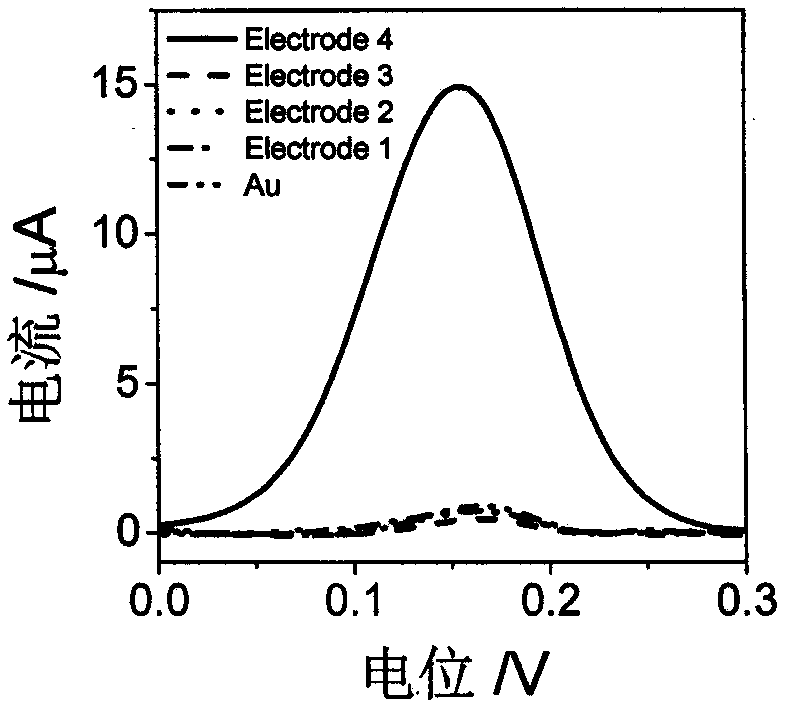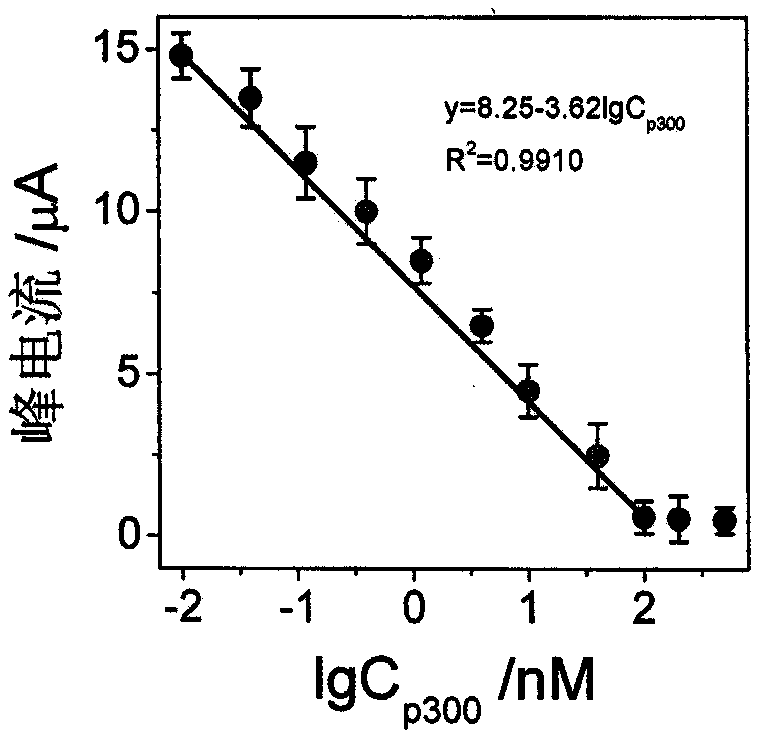Preparation method of electrochemical biosensor for simultaneously detecting HAT and TdT and application thereof
A biosensor and electrochemical technology, applied in the field of functional biomaterials and biosensing, to achieve high sensitivity, detection, and high-sensitivity detection
- Summary
- Abstract
- Description
- Claims
- Application Information
AI Technical Summary
Problems solved by technology
Method used
Image
Examples
Embodiment 1
[0029] Example 1 Preparation of sensor
[0030] (1) Combine DNA (5μL, 0.5μM) and Hg 2+ (5μL, 1μM), mix well, put it at 37°C for 60min, and drop it on the surface of a clean bare gold electrode (Au). The electrode was slowly buffered and washed with distilled water, and then mercaptohexanol (MCH) (5 μL, 1 mM) was added dropwise and allowed to stand for 30 min at room temperature. The electrode was buffered and washed with distilled water, which was recorded as Electrode 1.
[0031] (2) Take acetyltransferase p300 (1000nM, 0.1μL), peptides (1mM, 0.4μL) and acetyl-CoA (1mM, 1μL) separately in phosphate buffer solution (PBS, 10mM, pH 7.0) and mix well, the total volume 2μL. The reaction solution was placed in a constant temperature water bath at 30°C and incubated for 30 minutes. Spread it on Electrode 1, place it at 30°C for 30 minutes, and wash the electrode slowly with distilled water, denoted as Electrode 2.
[0032] (3) Take the Exo I solution (5μL, 50U / mL) and apply it to the su...
Embodiment 2
[0035] Example 2 Feasibility experiment of p300 detection
[0036] In order to prove that the sensor of the present invention can detect p300, our biosensor was prepared based on Example 1. During the acetylation reaction process in step (2), the reaction solution was used for the preparation of repair electrodes under the conditions of p300 and no p300. biological sensor. see figure 2 When there is p300, the sensor basically has no electrochemical response in PBS (0.1M, pH 7.0), but when there is no p300, there is an obvious electrochemical response, which proves that the sensor can be used for p300 activity detection.
Embodiment 3
[0037] Example 3 Detection of p300 enzyme activity
[0038] Prepare our biosensor based on Example 1 for the detection of p300 activity. The concentration of p300 is: 0, 0.01, 0.04, 0.12, 0.4, 1.2, 4, 10, 40, 100, 200, 500 nM, and the preparation of different concentrations of p300 The electrochemical response of the obtained sensor to PBS (0.1M, pH 7.0) electrolyte solution, see the experimental results image 3 , Indicating that as the concentration of p300 increases, the electrochemical response of the sensor becomes weaker, and the peak current has a good linear relationship with the logarithm of the concentration of p300. The linear correlation equation is y=8.25-3.62lgCp300, R 2 =0.9910, the linear range is 0.01~500nM, and the detection limit is 3pM, indicating that the sensor can achieve high sensitivity detection of p300 activity.
PUM
 Login to View More
Login to View More Abstract
Description
Claims
Application Information
 Login to View More
Login to View More - R&D
- Intellectual Property
- Life Sciences
- Materials
- Tech Scout
- Unparalleled Data Quality
- Higher Quality Content
- 60% Fewer Hallucinations
Browse by: Latest US Patents, China's latest patents, Technical Efficacy Thesaurus, Application Domain, Technology Topic, Popular Technical Reports.
© 2025 PatSnap. All rights reserved.Legal|Privacy policy|Modern Slavery Act Transparency Statement|Sitemap|About US| Contact US: help@patsnap.com



